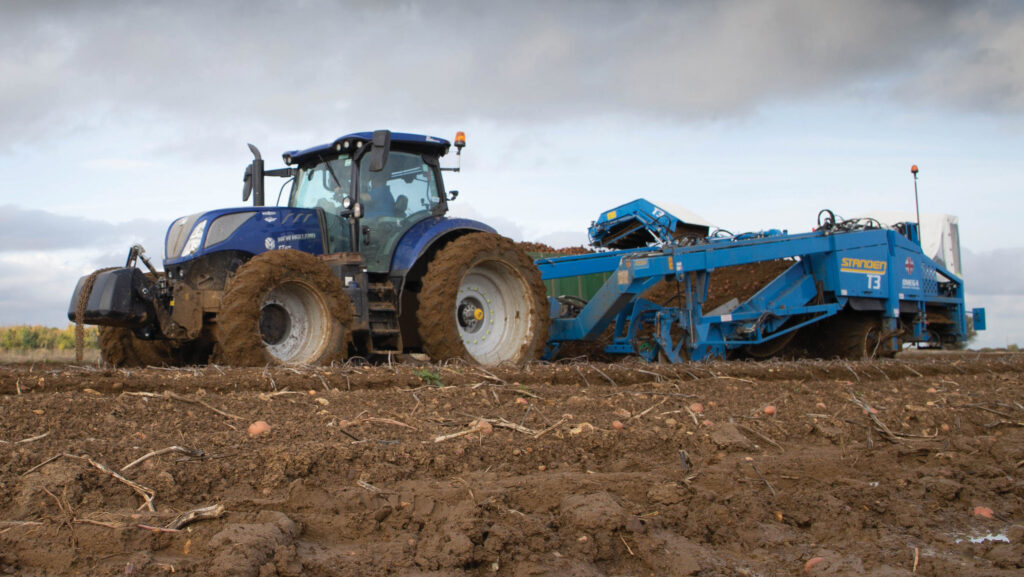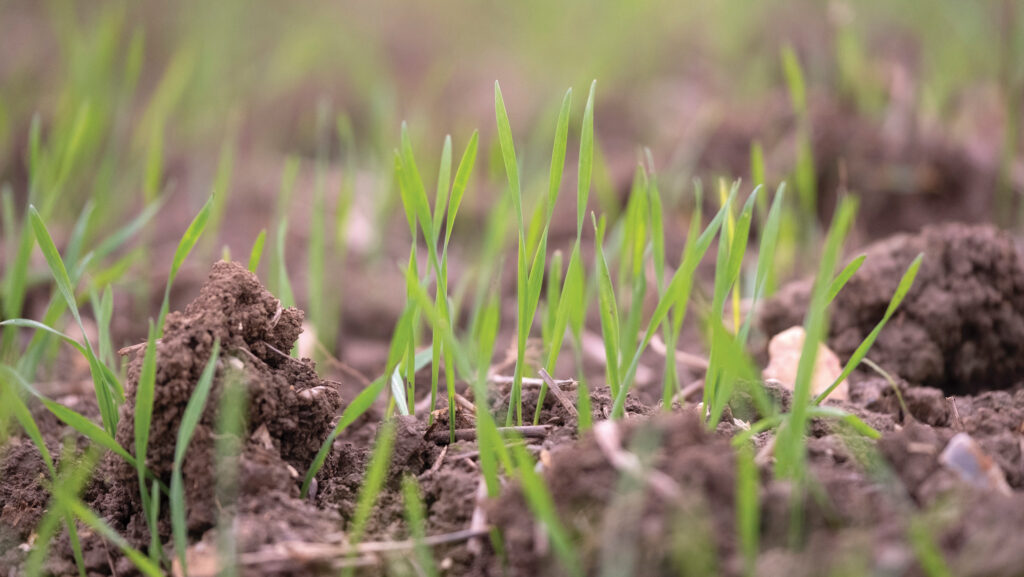Crop Watch: Worst maize harvest and spud storage rot risk
 © Tim Scrivener
© Tim Scrivener This year’s maize harvest is shaping up to be one of the worst in the past five years, according to one of our agronomists. Soils may need some remedial action to repair the damage.
Elsewhere, the potato harvest is progressing, with some farmers nearly finished while others are just beginning.
The wet conditions mean good store management will be needed to minimise rots.
See also: How an organic estate hits £1,000/ha gross margins
West
Ben Allard
Pearce Seeds (Dorset, Wiltshire and Somerset)
I would love to begin my first Crop Watch article on a positive note, highlighting that all autumn cereals have been drilled, pre-emergence applications completed, and that the maize harvest has gone smoothly.
Unfortunately, this is far from the case!
Another few weeks of wet and challenging weather have passed, leaving many in the West struggling to get their cereals in.
The limited number of spray days has made pre-emergence applications particularly difficult.
Growers with lighter, well-draining soils have made good progress in their drilling campaigns, with their soil type being a blessing this year.
In contrast, those with heavier soils are battling to make the most of the limited drilling windows.
My main concern lies with growers facing high blackgrass and ryegrass pressure; they may not achieve the desired level of weed control, as pre-emergence applications are rapidly turning into post-emergence applications.
With such high-pressure levels, there is little wiggle room in autumn herbicide strategies.
For those in this situation, I advise waiting and assessing the weather for 48 hours post-drilling to ensure a strong start to the autumn spray campaign.
Maize harvest
This year’s maize harvest is shaping up to be one of the worst in the past five years.
While growers who have strip-tilled or undersown their maize benefit from reduced damage during harvesting, the process remains challenging.
Fields will need careful assessment post-harvest, and significant remediation work will be required to restore the soil structure compromised by relentless rain and poor harvest conditions.
Yield-wise, it appears to be an average year for maize, with certain varieties, such as Anastasio and Dignity, standing out and performing well during the growing season.
Notably, this year’s maize has taken longer to mature – even early-maturing varieties are slow to ripen, and its not the year for a late harvest.
Oilseed rape
I have a sense of optimism for this season’s oilseed rape, which have established well and are facing low pressures from cabbage stem flea beetle.
While growers are fighting with high slug pressure, attention is also turning to phoma control, with fungicides like prothioconazole applied to affected crops.
Additionally, broad-leaved weed control plans are being implemented, with Belkar (halauxifen + picloram) used to keep crops clean going into winter.
As the autumn drilling campaign stretches into November, many will have to drill on a cold, frosty night into less-than-ideal conditions.
Interestingly, in the Philippines, there is an old saying: “sowing seeds under a cold moonlit sky promises an abundant harvest”.
So, before you dismiss it remember that an unplanned and an unconventional path can lead to the riches rewards”!
East
Harriet Bateman
Prime Agriculture (Norfolk and Suffolk)
The recent weather has caused varied drilling progress in the East, depending on land type and soil conditions.
Generally, progress is better than expected with growers making use of the warm, still days in between the unpredictable showers.
Winter barley is all in, with earlier drilled crops up and some receiving a top-up of grass weed control herbicides such as flufenacet, as well as receiving barley yellow dwarf virus (BYDV) control sprays.
With winter wheat still going in the ground, be mindful to comply with label guidance on depth and soil coverage to give crop safety when applying pre-emergence herbicides.
Seed-beds are not as consolidated as in previous years, with many fields left unrolled.
Earlier drilled wheat in September and early October is up, and where grassweed pressure is high, a peri-emergence spray will be applied.
The moist soil should give good conditions for grass and broad-leaved weeds control.
In both wheat and barley, numbers of aphids, primarily the bird cherry-oat aphid, are relatively high (see Rothamsted Insect Survey).
BYDV sprays on susceptible varieties should be well-timed at the 1 to 2 leaf stage or more precisely using a T-Sum 170-day degree calculation, using an integrated pest management tool such as the AHDB BYDV Management Tool.
Incidentally, these treatments will also help control of gout fly on the earlier drilled crops.
BYDV resistant varieties and crops grown under SFI option NUM 4 (no insecticides) will remain untreated.
Slug pressure
Slug pressure remains extremely high. The warm, moist and poorly consolidated ground has led to large slug numbers on the surface, and there is evidence of seed hollowing.
Put out bait traps, keep checking them and treat accordingly.
Oilseed rape crops generally seem to be looking well.
Any Centurion Max (clethodim) should have been applied by now according to label restrictions, and growers will potentially be thinking about broad-leaved weed control such as Belkar.
Crops should be monitored closely for phoma lesions; fungicide treatment should be applied when lesions appear at threshold (10% plants infected).
Prioritise varieties with lower disease resistance and those with smaller canopies, which are more vulnerable. The AHDB phoma forecast can help time treatments.
Sugar beet harvest is continuing with good progress, despite the recent rainfall. The sugar content remains just below average, but most are satisfied with the yields.
Growers are cultivating and drilling almost behind the harvester, where conditions allow.
Potato growers are still harvesting. Some growers are nearly at the end of the lifting season while others are just beginning.
Yields so far seem to be average, but the size of tubers is better than expected.
Tubers are cooler than the ambient temperature which is increasing the risk of condensation in-store, meaning a greater emphasis on air flow is required.
Keep an eye out for stocks with bacterial rots during this pull-down period.
South
Neil Harper
Agrii (Kent)
I want to begin my first Crop Watch column by thanking my colleague, Iain Richards, who has shared his thoughts in this slot for many years. I have big shoes to fill.
This appears to be another season where flexibility will be critical. The last two autumns have shown us that there is a wide drilling window.
If conditions are not right, we will have to be brave enough to say so and wait for it to improve.
Oilseed rape has been established well. There’s a mixture of early and late drilling dates. We have some crops at 8-9 leaves and others at 2-3 leaves.
The weather has allowed a good flush of grassweeds in oilseed rape.
We’ve been pleased with the timing and application of clethodim, and we are now thinking of propyzamide applications. However, looking at soil temperatures, this won’t be until November at the earliest.
Nutrition is a big priority for the autumn, ensuring the levels of phosphate, boron, and molybdenum are correct.
Aiding plant health and rooting will create a great foundation later in the season.
There is some phoma in canopies, but it is not at the threshold. We will start incubating leaves to assess light leaf spot because we want to be in a protectant situation.
An autumn fungicide may be needed, but our focus on plant health helps greatly with disease prevention.
Wheat drilling
It’s hard to know how much wheat has been drilled, but our gut feeling is 25-30%. Early drilled seed-beds were excellent.
However, the boundaries have started to be pushed in the last couple of weeks, which we will need to bear in mind with pre-emergence herbicides.
Careful decision-making is needed once the seed has gone in.
If the seed-bed isn’t appropriate, we may have to leave it to peri-emergence, understanding what that might mean for our weed control programme if we change our product choice and application timing.
About 75-80% of our winter barley is planted and had its pre-emergence herbicide. It looks well, although some crops are starting to look yellow.
Barley is sensitive at the best of times, and significant rainfall events have washed the herbicide down to the crop, giving us a further reminder of crop effects for wheat programmes.
Pulses performed very well last year, with good yields and gross margins. It also gives us another chance at creating stale seed-beds and different chemistry for blackgrass.
We will start thinking of planting winter beans towards the end of the month.
Testing seeds for nematodes will be important, especially with more legumes from various Sustainable Farming Incentive measures in the rotation. Seed rates will be adjusted depending on the results.
All things considered, there is more to do than we would usually like to have at this point in the autumn, but the past few years have proven that late-drilled crops can perform well if they have good establishment conditions.
North
Mary Munro
Munro Agricultural Consultancy
October has provided enough dry days for farmers to make progress with drilling, but it has been very picky and we seem to get a night of rain after every decent day.
This means that there are lots of wheat crops sown, but not rolled, and lots of wheat still to get autumn herbicide.
Interestingly, slug damage has been less than I expected, and pellets applied at sowing have not needed a follow-up.
By no means have all fields received a molluscicide, but the regular offenders are the heavier soils with a tendency towards cloddy tilth, or where wheat follows OSR.
The potato harvest rolls on, and there is still a fair amount of wheat planned to go in behind it if conditions allow.
It is too early to abandon the cereal spray choices, as there can be little windows of ideal conditions later in the year, but as winter closes in thoughts turn to spring options.
The worst issue with this is probably annual meadow grass, which can be big and tussocky by springtime, and I much prefer to hit them in the autumn.
However, I am scaling back the autumn orders to match the areas sown. We are fortunate to have a good distribution system and products available at quite short notice, which is a great help.

© Tim Scrivener
OSR herbicides
Oilseed rape is getting Belkar (halauxifen + picloram) plus Kerb (propyzamide) to tidy up broad-leaved weeds and keep the lid on bromes, which are a constant challenge in our part of the world.
There are only two months left for farmers to get a subsidised carbon audit and soil analysis under the Scottish government “Preparing for Sustainable Farming” scheme.
Arable farmers can choose two options to meet the requirements for the 2025 claim out of carbon audit, biodiversity audit, soil analysis (including soil carbon) and integrated pest management plan.
Mixed farms have the added option of an animal health plan.
This is creating a rush for carbon audits, as they will be valid for five years for the purposes of claiming the Basic Payment Scheme (BPS), but the funding expires at the end of this year.
We still don’t know what the budget for BPS will be – whether there is any clarity after the Westminster Budget remains to be seen.

